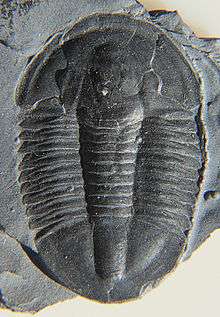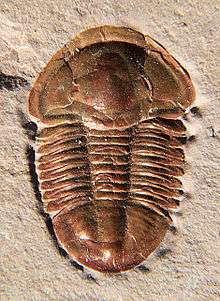Asaphiscus
Asaphiscus is a genus of trilobite that lived in the Cambrian. Its remains have been found in Australia and North America, especially in Utah.

| Asaphiscus | |
|---|---|
 | |
| Asaphiscus wheeleri, Cambrian shale, Utah | |
| Scientific classification | |
| Kingdom: | |
| Phylum: | |
| Class: | |
| Order: | |
| Family: | Asaphiscidae |
| Genus: | Asaphiscus Meek, 1873 |
| Species | |
| Synonyms | |
|
Eteraspis | |
Distribution
Description
Asaphiscus are average size trilobites of (up to 8 centimetres or 3.1 inches) with a rather flat calcified dorsal exoskeleton of inverted egg-shaped outline, about 1½× longer than wide, with the widest point near the back of the headshield (or cephalon). The cephalon is about 40% of the body length, is semi-circular in shape, has wide rounded genal angles, and a well defined border of about ⅛× the length of the cephalon. The central raised area of the cephalon (or glabella is conical in outline with a wide rounded front and is separated from the border by a preglabellar field of about ⅛× the length of the cephalon, and has 3 sets of furrows that may be clear or inconspicuous. The articulated middle part of the body (or thorax) has 7-11 segments (9 in A. wheeleri), with rounded tips. The tailshield (or pygidium) is about 30% of the body length, is semi-circular in shape, with a wide flat border, and an entire margin.[3]
Reassigned species
Some species originally described as belonging to Asaphiscus have later been reassigned to other genera.[4]
- A. capella = Glyphaspis capella
- A. granulatus = Genevievella granulata
- A. gregarius = Blainia gregarius
- A. minor = Cedaria minor
- A. unispinus = Weeksina unispina
Sources
- A Pictorial Guide to Fossils by Gerard Ramon Case
References
- Conway Morris, S.; Robison, R.A. (1986). "Middle Cambrian priapulids and other soft-bodied fossils from Utah and Spain". University of Kansas Paleontological Contributions. 117: 1–22. cited on Paul Hearn. "Lower Wheeler Shale". Fossilworks. Retrieved 2015-01-16.
- Robison, R.A. (1971). "Additional Middle Cambrian trilobites from the Wheeler Shale of Utah". Journal of Paleontology. 45 (5): 796–804. cited on Shenan Peeters. "Wheeler Formation, House Range, Utah". Fossilworks. Retrieved 2015-01-16.
- Moore, R.C. (1959). Arthropoda I - Arthropoda General Features, Proarthropoda, Euarthropoda General Features, Trilobitomorpha. Treatise on Invertebrate Paleontology. Part O. Boulder, Colorado/Lawrence, Kansas: Geological Society of America/University of Kansas Press. pp. O290–O291. ISBN 0-8137-3015-5.
- Peters, S.E. (2003). "Paleontology and taphonomy of the Upper Weeks Formation (Cambrian, Upper Marjuman, Cedaria Zone) of western Utah" (PDF). Unpublished PhD dissertation. University of Chicago.
External links
- Asaphiscus in the Paleobiology Database